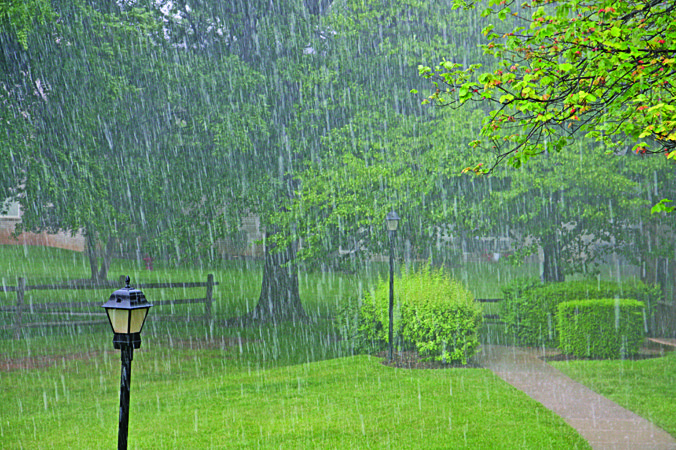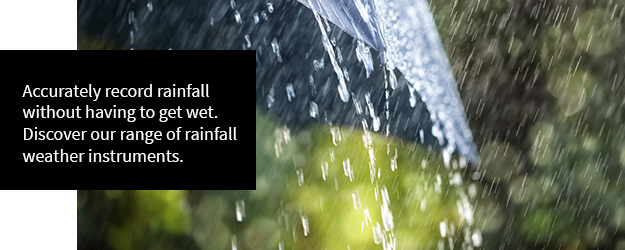5 Benefits of Measuring Rainfall at Your Home

The rainfall amounts in your neighborhood matter more than you might think — especially if you have a lot of outdoor hobbies or maintain a garden at home. Local weather channels and websites can provide a general idea of the rain in your area, but often those measurements can be recorded upwards of 10 to 20 miles away from your location. Many people need and want more accurate information than what they’re seeing on TV or on their smartphones.
Monitoring the rainfall totals directly at your home can be beneficial in keeping your yard healthy as well as help you plan your activities for the day. Keep reading to learn the top five benefits of using a rain measuring instrument at home.
1. Keeping Your Plants and Grass Well-Watered
Rainfall totals matter most when you’re trying to keep your lawn and garden healthy. Too much or too little water can cause issues for your yard and plants. Using a rain gauge to measure precipitation can take the guesswork out of deciding how much to water your plants between rainfalls. It will also help you determine whether you should use sprinklers to water your lawn as well as measure how much water your plants are getting from the sprinklers. This valuable information can save you from wasting water and money, while also preventing you from over-saturating the ground.
A rain measuring instrument can also help you monitor if your plants and grass are getting too much water if you notice unusually large amounts of rainfall over a period of time. While too little water can cause plants to dry and shrivel, too much water can lead to root problems, diseases, loss of nutrients, more insect problems, or more weeds. If your yard is getting too much water, you could add fill dirt, increase seeding to absorb more water, or adjust the drainage from your gutters to avoid puddles from forming.
In addition to home gardening, one of the most important reasons is for agricultural purposes. Farmers need to know how much rain has fallen in order to determine how much water their crops need. Too little rain can cause droughts, while too much rain can lead to crop damage from flooding. Measuring rainfall can help farmers ensure that their crops are getting the perfect amount of hydration and ensure a good crop yield.
2. Identifying Weather Patterns and Trends for Your Neighborhood
Is your neighborhood headed for a drought? Has precipitation been increasing or decreasing? Measuring the weather patterns around your neighborhood can be a fun, interesting hobby and provide conversational material for your family, friends and neighbors. One reason to purchase a rain gauge is simply to satisfy your own curiosity about the environment around you. You can even teach your children about rainfall, why it matters, and what it means when it’s trending up or down.
Monitoring rainfall amounts can even help you determine what outdoor activities to plan for the day. For example if there’s been a lot of overnight rain while you were sleeping, it might not be the best time to go golfing or have your children play outside in a muddy yard.
Additionally, measuring rainfall can help us understand climate change and its effects on our planet. By tracking changes in precipitation patterns over time, we can see trends that may not be apparent at first glance.
3. Knowing the Best Times for Planting
Since some plants need more water than others, every type of plant has an ideal rainfall amount for seed germination and to stay healthy throughout the season, with some plants needing more water than others. It’s difficult to guess water levels. You may know from looking out the window how long it rained or how hard it rained, but you might not know exactly how much rain has fallen at your home. This is especially true when rainstorms have been erratic or when a rainy season has lasted longer than it should.
By precisely measuring precipitation with a rain gauge, you’ll know when it’s the right time to plant certain types of flowers, vegetables, fruits, or even trees. You will also know when rainfall amounts are beneath optimal levels, so you can supplement with your own water. This will make it far more likely that your planting will be successful, cutting down on the amount of time you spend in your garden and yielding the best results.
4. Identifying Potential Conditions for Flooding
Monitoring rainfall totals becomes even more important if you’re in an area that’s prone to flooding. A rain gauge lets you identify potential flooding conditions that could adversely impact your yard and home. If you’re seeing unusually high rainfall amounts over a period of time, it could indicate potential flooding for your yard, garage or basement. With the ground fully saturated, the rain will have no choice but to run off, which could wash away newly planted seeds or fertilizer, damage your garden, or leak into your home causing costly water damage. By measuring and tracking the rainfall, you’ll be able to stay aware of your environment and prepare appropriately for potential issues.
You also don’t need to be in a flood zone to benefit from measuring precipitation at your home. There can be unexpected floods in areas that wouldn’t otherwise experience them, especially following droughts and unusually strong or frequent rainstorms. An affordable, easy-to-install rain gauge is a very simple way to track and notice water issues even if you don’t think you’re likely to encounter them.
In addition to general flooding, flash flooding can occur when there is a large amount of rain in a short period of time, and this can be dangerous for both people and property. By measuring rainfall, meteorologists can issue warnings and allow people living in flood-prone areas to take precautions ahead of time.
5. Getting Better Rainfall Data
Though there are some ways to track rainfall — such as local weather channels and news websites — they usually don’t have very precise data. Their measurements are often limited to specific regions and geographical locations. They can’t measure the area directly around your home, which could be impacted either more or less than where their sensors are located. Think of a thunderstorm that rolls through your neighborhood dumping buckets of rain in just a few minutes, while other areas just one mile away get no rain at all. Your rain gauge will be able to tell you exactly how much rain is falling around your property, even if it may not be raining as much in other cities nearby.
Measuring and tracking rainfall totals at your home is an easy, useful activity that provides many benefits. An affordable rain measuring instrument can arm you with precise, detailed information about the water around your home and it could even be a decorative focal point depending on the style you chose. Homeowners who put a lot of work into their garden or lawn will find a rain gauge almost essential — but those who are just generally interested in the weather and its trends will also find it an interesting way to fulfill their curiosity.
Are you ready to start measuring the rainfall at your home? Browse through Maximum’s selection of rain measuring instruments today. Or, if you have a question for a member of our team, feel free to contact us to get started.

